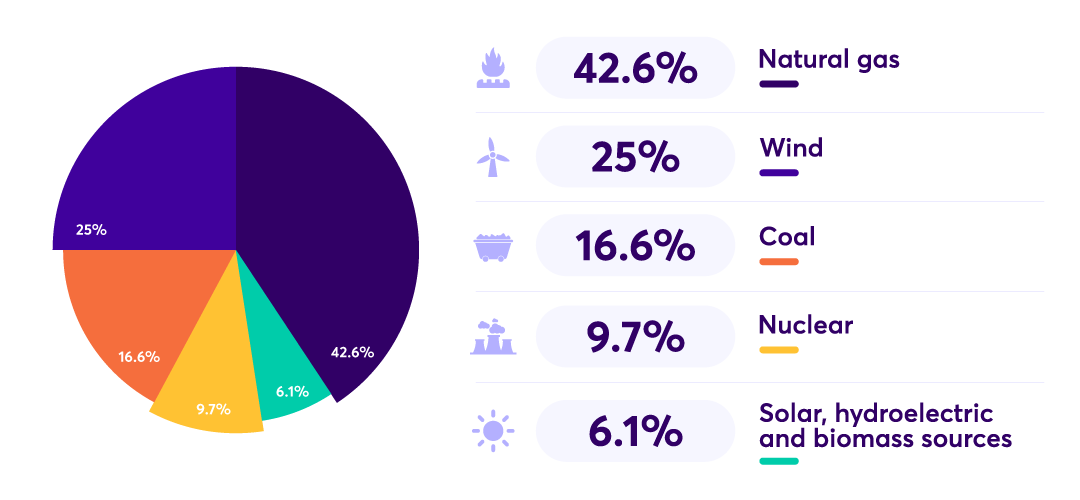Get ready for the most exciting thing you'll read all day: When is the best time to renew your electricity contract in Texas? In short, the best time often falls between late fall and early spring when demand is moderate and prices are generally lower. Avoid peak summer months whenever possible. By timing your renewal to these “shoulder seasons” and considering contract lengths that shift your end date away from peak-rate months, you’ll likely lock in more stable and affordable rates.
For Texas residents looking to renew an electricity contract, timing is everything. The rate you lock in today could significantly impact your energy bill for the next six, twelve, or even twenty-four months. Factors like extreme weather, fluctuations in natural gas prices, and renewable energy availability all influence what you’ll pay.
We’ll explain the best months to renew your electricity plan in Texas, how to dodge summer spikes, and why shorter or unconventional contract lengths can sometimes play in your favor. We’ll also delve into actionable strategies—like leveraging Rhythm Energy’s easy digital tools and exploring their PowerShift plan—to take charge of your energy usage and enjoy more predictable bills.
Timing Is Everything: 'Tis the Season(s) that Play a Huge Role
Securing a great electricity contract price isn’t just about finding a good rate today; it’s about understanding the energy market’s seasonal rhythm. Texas electricity rates often spike when the thermometer soars, typically between June and August. During these months, widespread air conditioner usage pushes demand sky-high, and electricity providers must source more expensive generation. The result? Higher rates passed on to consumers.
Summer Surge: In peak summer, electricity usage skyrockets. Even an extra month locked into a summer-heavy contract can mean higher overall costs.
Winter Variability: Although Texas winters are mild compared to other states, cold snaps can still trigger demand spikes, as we’ve seen in recent years. However, they’re generally shorter-lived than summer peaks.
Shoulder Seasons (Spring & Fall): The mild conditions in April, May, September, and October typically see lower energy demand. With less strain on the grid, providers often offer more competitive, stable rates.
Key Takeaway: Aim to have your contract end and renew during these shoulder months for the best shot at lower prices.
How Natural Gas and Renewables Influence Your Contract Timing
Nearly half of Texas’ electricity still comes from natural gas-fired power plants. Natural gas prices, global supply, and weather all impact wholesale electricity costs, which eventually trickle down to retail rates. Meanwhile, Texas continues ramping up renewable energy (like wind and solar), which can ease long-term prices but also introduce variability depending on weather conditions.

Natural Gas Prices: Cheaper gas generally leads to cheaper electricity, especially during non-peak periods.
Renewable Output: High wind or solar output during mild months can flatten prices, making spring and fall even more appealing for renewing.
Key Takeaway: The trick is to watch these trends—or let a trusted REP guide you—to determine if prices are on an upswing or if now is a good time to lock in a rate.
Avoid Peak Season Electricity Costs, and You're Golden
If your contract ends in mid-July, chances are you’ll face steeper rates. While you can’t always control your contract’s expiration date, you have options.
Switch Early (If Allowed): If you’re within your final 14 days of the current term, Texas rules often let you switch without penalty. This can help you pivot into a better time frame.
Try Short-Term Plans: If you’re stuck renewing in June, consider a 3- or 6-month contract. While shorter plans may not have rock-bottom rates, they can land you in a better renewal position during off-peak months.
Blend and Extend: Some providers may let you extend your current plan’s length with slightly adjusted pricing, placing your next renewal window squarely in spring or fall.
Strategically Choosing Contract Length
Not all contracts are created equal, and length matters. A 12-month contract covers all seasons, averaging out peaks and troughs. But what if you strategically pick a 9- or 15-month contract to end right before summer hits?
12-Month Plans: These offer stability and simplicity. You’ll pay a blend of peak and off-peak rates, but might miss out on fine-tuning your renewal timing.
Shorter Plans (3 or 6 Months): These can help you “reset” your renewal date. For example, signing a 6-month contract in June lands you in December for your next renewal, likely improving your odds of better pricing.
Longer Plans (24 Months+): If you find a great rate during a shoulder season, consider locking it in for 24 months. You’ll avoid the hassle of shopping again during peak demand cycles.

Pro Tip: Compare the total annualized cost of different contract lengths. Sometimes a slightly higher off-peak rate is worth it if it repositions you for a future renewal in a low-demand month.
Leveraging Rhythm Energy’s Digital Tools for Smarter Renewals
Internal Links to Rhythm Energy pages:
Rhythm Energy offers convenient digital tools and plans that can help you manage your usage and costs:
My Account Dashboard: Monitor your daily and weekly usage patterns. If you know when you use the most electricity, you can tailor your habits—like running appliances in off-peak times—especially if you’re on a Time-of-Use (TOU) plan.
PowerShift Plan: This TOU plan rewards shifting your electricity usage to off-peak hours. Even if you renew during a neutral season, using a TOU plan effectively can save big over time. For example, charge your EV overnight or run high-demand appliances during cheaper periods to offset any slight increase in contract price.
Protection Plans: Consider surge protection or HVAC/plumbing protection. While these won’t directly lower your contract’s kWh rate, they shield you from costly repairs that could offset any energy savings you’ve achieved.
By combining the right contract timing with Rhythm’s digital tools, you not only find a better rate but also gain year-round control over your electricity expenses.
External Factors: Policy, Infrastructure, and Weather
Changes at the grid operator (ERCOT) level, such as capacity additions or retirements, also influence long-term pricing. Monitoring industry news or subscribing to a service that tracks these changes can guide you when selecting contract lengths and timing.
Some Helpful Resources:
These resources provide insight into broader market conditions and help you anticipate when rates might be lower. For instance, if ERCOT projects a surplus of capacity during spring, you might find better deals in those months.
If You Remember Just a Few Things...
Aim to renew your electricity contract in spring or fall to avoid peak summer and winter rates.
Consider shorter contracts to shift your renewal date into a low-demand season.
Renewable output and natural gas prices significantly impact Texas electricity costs.
Leverage flexible Time-of-Use plans like Rhythm Energy’s PowerShift to save when usage timing counts.
Monitor market trends: If rates are currently high, opt for a short plan and switch to a better deal later.
Use digital dashboards and tools to track energy usage and make informed decisions.
Explore home protection plans to mitigate unexpected costs that can derail your energy budget.
Don’t forget the tools at your disposal. Companies like Rhythm Energy let you monitor your energy use in real-time, pick contract lengths suited to your lifestyle, and even shift your consumption to cheaper hours with a plan like PowerShift. With these strategies, you’ll not only find a favorable contract but also get peace of mind knowing you’re minimizing costs and volatility.
FAQ
When is the cheapest time of year to renew an electricity contract in Texas?
Typically, late fall or early spring offer the most stable and lower rates since demand is moderate and providers aren’t under seasonal strain.
How do summer months affect my electricity rate?
Summer increases demand for cooling, pushing wholesale rates up. Renewing in peak summer often locks you into higher costs for the long term.
Should I choose a shorter contract to avoid high-rate seasons?
Yes. A short-term contract can shift your next renewal to an off-peak period, helping you secure better rates later.
Are Time-of-Use (TOU) plans beneficial?
TOU plans, like Rhythm’s PowerShift, let you save by using electricity during lower-cost, off-peak hours. This can offset seasonal highs.
What if I’m stuck with a contract ending in peak season?
Consider renegotiating or choosing a short-term contract. It might mean a temporary compromise, but it positions you for lower rates in the future.




